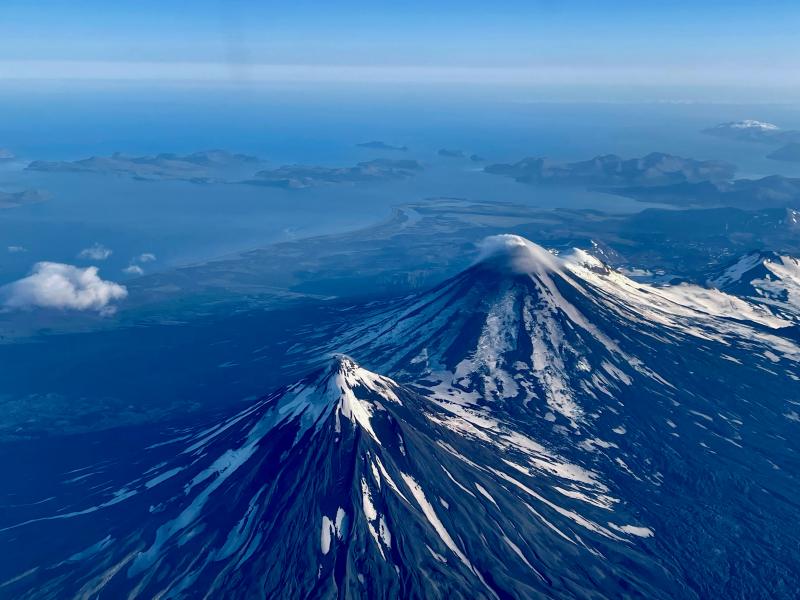
Pavlof, evening of August 5, 2021.
Volcano(es):
Photographer: Milliard, John
URL: avo.alaska.edu/image/view/175261
Pavlof 2021/08
From Orr and others, 2024: "After a 9-month quiescent period that started in late 2020, seismic activity at Pavlof Volcano increased on July 9, 2021, in a distinct change from its background levels. Tremor periods observed on that date prompted AVO to increase the Aviation Color Code and Volcano Alert Level from GREEN and NORMAL to YELLOW and ADVISORY. From July 9 to August 5, seismic activity at the volcano was characterized by more volcanic tremor periods and occasional low frequency events, but no outward signs of eruptive activity were observed.
"On August 5, 2021, clear webcam views of Pavlof Volcano showed episodic, low-level ash emissions. These intermittent ash bursts came from a new vent on the upper southeast flank of the volcano, which produced diffuse ash clouds that rose just above the summit and drifted roughly 10-15 km [6-9 mi] southeastward before dissipating. Seismic and infrasound data associated this activity with occasional small explosions and tremor. The ash emissions clearly indicated that an active eruption was in progress, so AVO raised the Aviation Color Code and Volcano Alert Level to ORANGE and WATCH later that day.
"Seismic and infrasound sensors regularly recorded small explosions through the rest of the year, and when viewing conditions permitted, minor ash emissions appeared in webcam views and were observed by pilots. Diffuse ash clouds intermittently rose as high as ~12,000 ft (~3,700 m) ASL and were visible in satellite data as far as 10-15 km [6-9 mi] beyond the vent. Ash fallout during this period settled mainly on the upper south-southeast flank of the volcano, within 2-3 km [1.2-1.9 mi] of the vent. Occasional stronger ash bursts and farther-traveling ash clouds may have produced trace amounts (less than 1/32 inch or 0.8 mm) of ash fall as far as 10-15 km [6-9 mi] southeast of the vent, but this amount of ash is difficult to observe in satellite data and so could not be confirmed.
On August 25 and 26, mid-infrared satellite images showed slightly elevated surface temperatures at the summit of the volcano for the first time. The detection of elevated surface temperatures in satellite data usually indicates that lava is at or near the surface; however, lava flows at Pavlof Volcano were not confirmed until November 8, when the thermal output at the vent increased considerably. The presence of shallow subsurface magma and hot gases may have contributed to the slightly elevated thermal signals observed between late August and early November.
"Satellite images acquired on November 11 showed an active lava flow or spatter accumulation, about 200 m in length, and associated lahar deposits (extending ~2 km [~1.2 mi] beyond the vent) on the upper southeast flank of the volcano. Many historical eruptions of Pavlof Volcano have been characterized by lava fountaining or jetting that result in the accumulation of spatter around the vent. Occasionally, these growing spatter piles become unstable and collapse, forming hot particulate flows that are capable of eroding and melting glacier ice and snow on the volcano. The formation of meltwater by this process is a primary mechanism for lahar generation at Pavlof Volcano (Waythomas and others, 2017). The eruptive activity in early November may have been characterized by such periods of lava fountaining, spatter accumulation, and the extrusion of hot, granular flows that produced the lahar deposits observed in satellite imagery. A Sentinel-2 short-wave infrared (SWIR) image from November 12 showed a circular area of hot material around the active vent, consistent with the notion that spatter accumulation had been occurring. However, none of the webcam views or occasional pilot reports from November and December confirmed incandescence or lava fountaining at the south flank vent.
"On November 17, satellite observations indicated both the presence of ballistic clasts around the vent (some located as far as 2.5 km [1.6 mi] away) and continued lahar development that was likely associated with ongoing lava-ice-snow interaction. The ballistic clasts were ejected during energetic explosions that were recorded in seismic and infrasound data during the week of November 12-18. Minor explosions and small ash emissions took place occasionally during the last two weeks of November 2021, although the volcano was obscured by clouds for much of this period.
"From late November through December, the Pavlof Volcano seismic network detected elevated seismicity consisting of episodic, sustained tremor periods and discrete low-frequency events. Many explosions were detected in seismic and infrasound data—these may have produced localized ballistic ejecta fallout around the active vent, as indicated by satellite data acquired on December 1, 2021. On December 4, a webcam and a passing aircraft recorded minor ash emissions that rose from the summit of the volcano to an altitude of ~10,000 ft (~3,000 m) ASL. Satellite data from this period also commonly indicated moderately to strongly elevated surface temperatures. High-resolution satellite imagery collected during clear weather commonly showed lava effusion on the upper southeast flank of the volcano, as well as continued interaction with snow and ice that subsequently produced small lahars downslope from the lava flows. For instance, satellite images obtained on December 19, 2021, showed both an ~600-m-long [~2,000-ft-long] lava flow and minor lahar deposits that extended ~1,300 m [~4,300 ft] beyond the flow front."
Pavlof remained at Aviation Color Code ORANGE for much of 2022, with intermittent lava effusion, small explosions, and low-level ash emissions. On December 17, 2022, AVO lowered the Aviation Color Code and Volcano Alert Level at Pavlof from ORANGE/WATCH to YELLOW/ADVISORY, stating that no explosions had been detected since December 11, 2022, and no elevated surface temperatures or incandescent lava since December 2, 2022. On January 19, 2023, AVO lowered the Aviation Color Code and Volcano Alert Level to GREEN/NORMAL.
Use Restriction: Please cite the photographer when using this image.
Full Resolution.